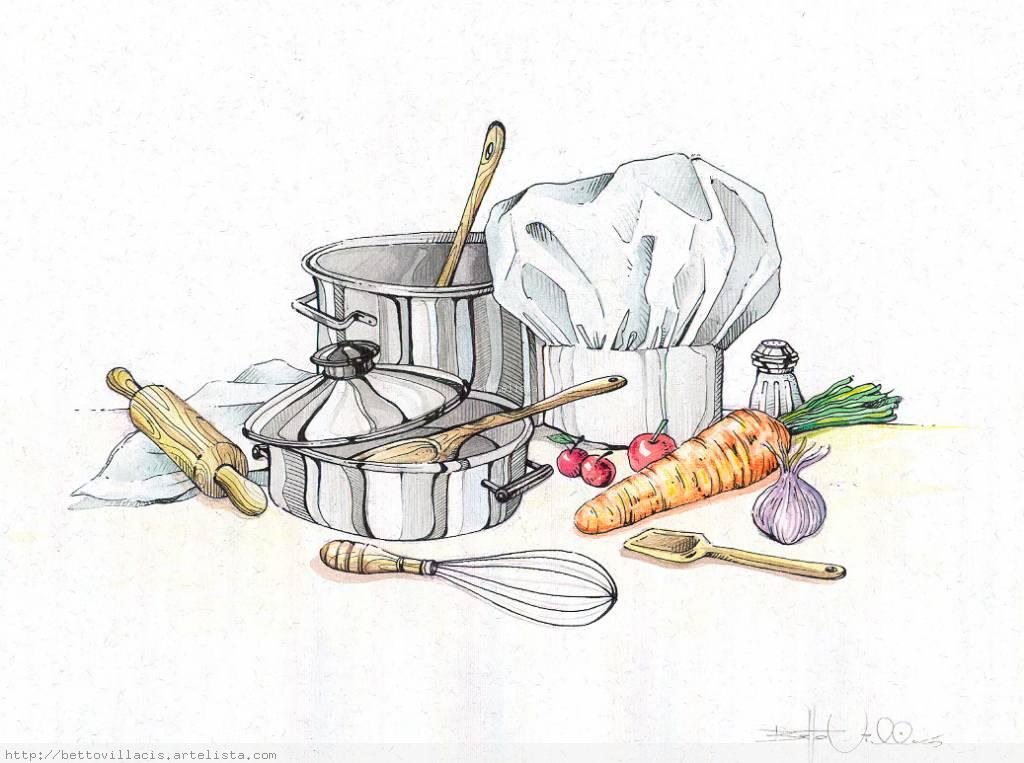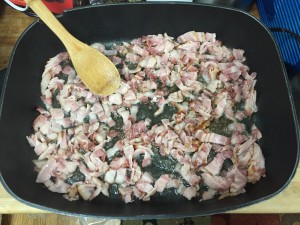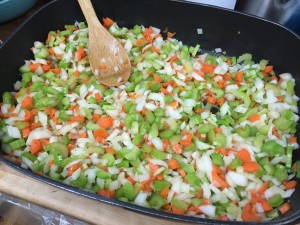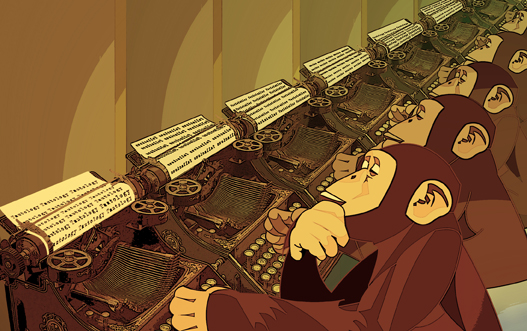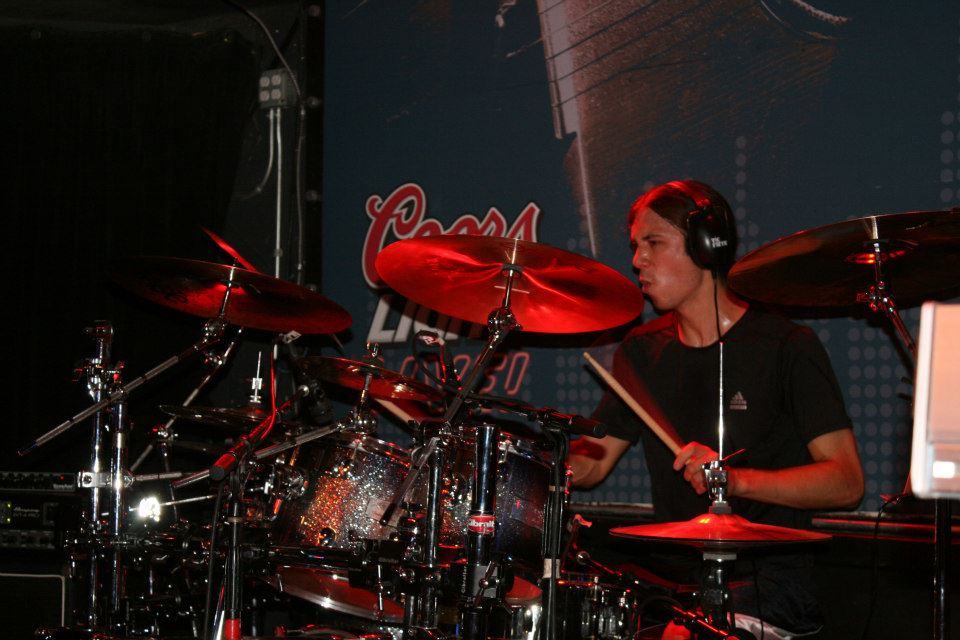One of my very first memories is cooking with my dad. He was sautéing asparagus and garlic in a skillet. The hiss of scalding hot butter crackled through a kitchen steeped in activity. My mom was pregnant with my brother and the neighbors were drinking Modelo Negro in the backyard. Every now and then my dad would flick his hand and green stalks, still steaming, would fly into the air. The process was effortless but the image, impossible to shake. When he was done he moved the pan from the burner and took a tray full of dry rubbed steaks out to the grill. The smell of hot coal was thick in the air and flames lapped at the metal grate my dad had lubed with olive oil. I can distinctly remember how confused I was that he was going to put our food into the fire. At that age the entire process was as unintelligible as it was thrilling. I remember getting close enough to feel the heat of the coal on my face. Red embers filled my eyes and I could not help but stand still in silence as my father slapped the meat down to cook. In that moment, under a lullaby of sizzling steak, I felt an inexplicable pull of curiosity. At the tender age of three, I fell in love.
A short five years after that and my childhood home was nicknamed “the knife house” because of my obsession with cooking and its tools. I loved fire like all young boys but it was my unwavering interest in sharp knives and the kitchen cutlery that earned me my reputation. Mandolins, food processors, cleavers, steak knives, hell, even potato peelers got my rocks off. I was a storm of mischief with a purpose, to cook like my father cooked; age be damned. And cook I did, from peanut butter and jelly sandwiches with pickles, strawberries, fruit rollups, and lunchmeat, to cereal with orange juice. I was a little boy with an unwavering dedication to experimentation and culinary excellence.
As a small kid I was an introvert. I had a difficult time expressing what I wanted to express. I was diagnosed in the fifth grade with ADHD and a speech impediment, which meant I was bad at talking and paying attention. So I didn’t, I spoke through my food, a process that allowed me to control my wild mind and apply it in a constructive way. When I had friends over I cooked them dinner. When I liked a girl, I packed her lunch. When I had parties or a birthday, I spent my time at the grill instead of in the jump house. At some point cooking went from a passion to a way of communication. It wasn’t that I didn’t want to hang out with friends or chitchat with a girl. It was just that food gave me a way to say the things I had always had trouble saying, to get across the feelings I had trouble showing. It was a conduit through which I could understand and communicate the world around me.
Cooking is a language all to itself. Take “Mom’s cooking” for example. What do you think of? Is it meatloaf with a ketchup sauce or maybe mashed potatoes and gravy? It could be hot tamales at Christmas time or gnocchi with meat sauce in spring. These meals do not only summon an image of food, they invoke an emotion, a memory. And it is that very association that I had discovered as a child. At age three food meant family, it meant friends. To others certain foods can carry cultural or even historical weight.
What do you think of when I say tortilla. In America we think of tortillas as a wrapping for a burrito or a taco. They are a shell, a simple but effective, and delicious, way of eating other things. They are not a focal point of a meal. In South America it is different. Instead of bread mothers and fathers make homemade tortillas. Instead of being completely flat and dry, fresh made tortillas are a bit thicker and elastic to the bite. To many Latin Americans this taste and feel represents not only their cultural heritage but also their family’s cooking. When you ask them what they think of when someone says tortilla they might answer that it conjures an image of their mother or father. That it is a warm and comforting food, something they make for their children or close family.
This is just one of the ways in which cooking can connect. Not only for me but also for anyone, food is a pathway to the heart. And as a cook, even from a young age I was constantly trying to figure out ways to share that moment with others. This passion for food and its ability to evoke powerful feelings has driven my passion to create. Getting a dish “right” requires more than a recipe and ingredients. There is an almost inexhaustible list of different skills that help guide the cooking process. Think of things like sautéing, knife work, flambéing, sauces, baking, and product knowledge. There are a million and one ways to improve how you compose a dish. The only limiting factor is practice.
At first the only things I was capable of making were simple variations on the classics. Things like chicken noodle soup with tortillas and avocado or meatloaf with chipotle ketchup gravy. Outside of these the bulk of my cooking used to revolve around a few sandwiches and sautéed vegetables. It took years of practice and research for me to learn how to BBQ and bake. At the time cookbooks quickly became a staple source of information and guidance. With Julia Child’s assistance I gradually began to learn about the fundamentals of cooking as a form of art. From France I learned sauces both butter based and wine-based. From Mexico came salsas and chilis and from Ireland I learned to make shepherd’s pie. It was during this period in my evolution, that I started to appreciate cooking outside of its ability to talk. I realized that for me to even begin to relay my feelings through a meal it needed to be properly prepared. I needed to learn about what it meant to respect traditions, to cook with technique and responsibility.
In a roundabout way this pressure is a primary source of motivation for me. It was honestly shocking to see how much there was to still learn and try and eat. Which is why I have never given up or gotten bored or burned out: because cooking isn’t so much a skill as it is a journey. From the mother who simply wants to provide for her kids to the super star who wants to create the world’s best flavors, the starting point is the same in either case.
I have access to the same techniques, the same recipes, and ingredients. I only need to pick a direction and learn. The only real difference is the extent to which I am willing to flesh out and meet my ever changing goals. In other words, the only limiting factor in cooking is imagination and determination. It is as simple or complex as you personally make it out to be, which is the beauty of cooking. It is a learning experience that only stops when you die. From your days spent as a college bachelor to the moment you find yourself with grandkids, cooking continues to be a relevant and powerful way to connect. A way to pass down parts of your history and life to the people you care about most. Which is where this love affair of mine started, at a BBQ when I was three. There are always new things to cook, new techniques to try, and new opportunities to connect to the people around me.
Even now I am still learning and in the spirit of this article, and the holidays, I thought I would try and connect with my readership. I would like to share with you all one of my favorite family recipes. Based deep in my childhood, this recipe comes from a very near and dear exchange student my family housed for over 7 years! It is classic Japanese comfort food, a play on fried rice.
I call it “Bacon Fried Rice,” or alternatively, “It is Literally Impossible To Hate This Dish Because It Is Has Bacon And Fried Rice, Two Of The Best Things Ever, Go Cook It And Eat It Now.”
To start off you are going to need these ingredients:
-Soy Sauce ( If I was forced to estimate an amount, 1 ½ cups.
-A healthy dollop Garlic
-White rice, any type or variation will do.
-1lb of Bacon
-1 ½ Onion
-5 Carrots
-5 stalks of Celery
-Salt
-2 TbsPepper
-4-5Green Onions
-A dozen Eggs (depending on how much you are making. For reference this recipe will make more than enough for a party of 3-4.)
Part of the reason I adore this recipe is because it keeps things simple. It is delicious without all the fuss that most gourmet food takes to prepare.
The very first thing you need to remember is to start cooking the rice early. It takes roughly twenty minutes to cook and is by far the most important part of the entire dish. This recipe takes about three cups of the white rice, which means about 5 cups of water. My personal trick with rice is to simply measure water into the cooker until there is about an inch of it above the resting rice. Some recipes call for 2 cups of water to every 1 cup of rice but I have found that more often than not this leads to cooked but mushy rice, which in fried rice is a killer.
Next, take a large pan and put it on med/high heat. Open the pound of bacon and cut it into small ½” by ½” inch pieces. Once the pan is hot enough to sizzle water, place the meat in and periodically stir until it has become brown and crispy (a process that takes about 15 minutes). Once that is done take the meat out with a strainer but leave both the pan and the rendered fat on the burner.
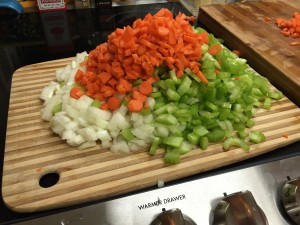
Next, finely dice your onion, celery, and carrots. You want your diced veggies to be about the size of a pea. Any bigger and the carrots have trouble cooking and any smaller and your nicely cut medley turns to mush.
Once you are done cutting place the vegetables in the bacon greased pan, which should still be on medium/high and cook them until they are translucent. This process is called sweating, and serves to both flavor the pan and ensure that the carrots are entirely cooked. Once that is done put your garlic in, the amount is entirely up to preference. I put in about a 1 ½ tablespoons. The reason we do this last is because garlic cooks far quicker than the rest of the dish and will burn if we throw it in at the same time as the other diced goods.
By this time your rice should be done, if it isn’t just turn your pan down to low and wait. Next take your cooked rice and stir it into your bacon lathered vegetables. Due to the sheer volume and weight only stir in about a ¼ of the pot at a time. Once the entire rice cooker is empty take your soy sauce and pour it over the newly mixed rice. Toss the rice until it turns color from white to golden brown. The process of adding soy sauce and tossing might have to be repeated multiple times for this to happen. To keep from over saturating the mixture with soy, only add about 2 tablespoons each time.
After you have achieved the glorious golden brown put the pan to the side and take out a skillet. Next crack anywhere from a half dozen to a dozen eggs depending on personal preference and taste and whisk them until they are thoroughly scrambled. Once the pan is hot put 2 tablespoons of butter in the pan to melt. Pick the pan up and coat the entire bottom and sides of the pan by moving it around in front of you. Feel free to swing it about, it is fun and makes you look like a real chef! Once coated take the beaten eggs and cook them until they are fluffy. If you notice either the smell of sulfur or pieces of browned egg then you have gone too far and your eggs are burning.
Once you have your eggs cooked dump them onto a cutting board and give them a rough chop before throwing them into your fried rice. At this point remember to take out your bacon bits and throw them in as well.
With that you are finished.
You have not only constructed a meal suited for the gods but you have also tasted one small fragment of my personal history and heritage. This meal represents one of my absolute favorite memories. It reminds me of good food and better friends. serves as a constant reminder to always live in the moment and cherish the people you meet. And now I am giving that memory to you. Somewhere halfway around the world in Japan our student is cooking this meal for his family. In California I still make this meal for friends, and now you all can make this meal. That silent, intangible connection is what cooking is all about. All that is left is for you plate that bad boy up and eat.

